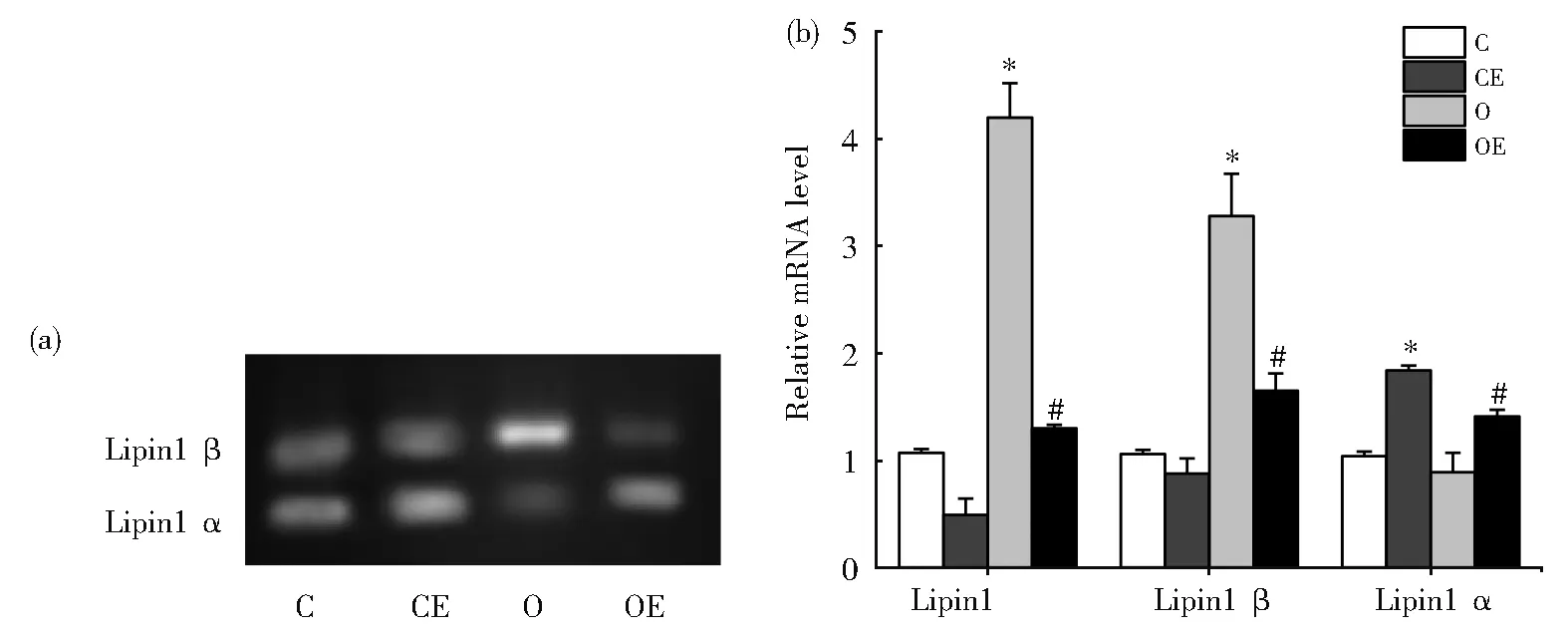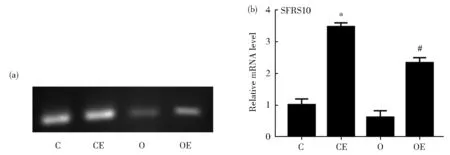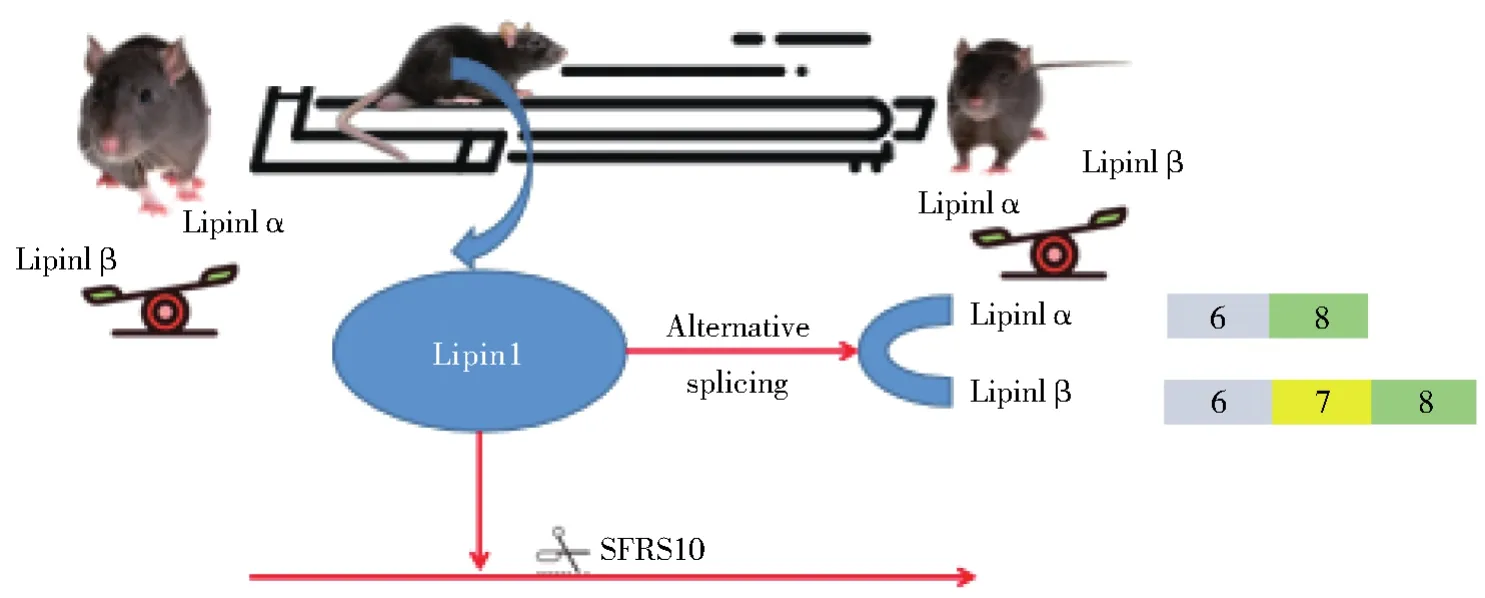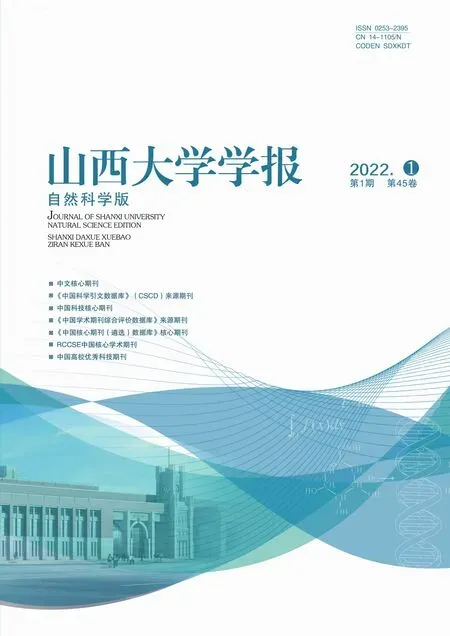Aerobic Exercise Reduces Body Weight by Regulating Lipin1 Pre-mRNA Alternative Splicing and Splicing Factor SFRS10
WU Bao’ai,XU Chong,DU Huizhi
(1.School of Physical Education,Shanxi University,Taiyuan 030006,China;2.Institute of Molecular Science,Shanxi University,Taiyuan 030006,China)
Abstract:The effects of the aerobic exercise on mice body weight,Lipin1 pre-mRNA alternative splicing and SFRS10 by hematoxy-lin-eosin staining were evaluated by PCR and qPCR techniques.The mice body weight had a significant decrease after the aerobic exercise.The lipin1 over-expressed in obesity group was decreased after the aerobic exercise.One of isoforms,the lipin1 α had a low expression in obesity group and increased after aerobic exercise,while,the other one,the lipin1 β had the opposite change from Lipin1 α.Moreover,it was found that SFRS10 was involved in the Lipin1 pre-mRNA alternative splicing induced by the aerobic ex-ercise.In a word,the aerobic exercise may lose the body weight by regulating Lipin1 level,Lipin1 pre-mRNA alternative splicing,and SFRS10.
Key words:aerobic exercise;obesity;weight loss;Lipin1;alternative splicing;SFRS10
1 Introduction
Obesity is one of the world-wide chronic diseas-es,and was mainly caused by the imbalance of energy intake and expenditure.Statistics indicated that the obese population had a rapid increase over the past 40 years[1].Besides,obesity is a leading cause of cancer,insulin resistance,and other metabolic complica-tions[2].Lipin1 that locates in chromosome 12,129.0 cM and contains 26 exons and 25 introns has close re-lationship to lipid metabolism and circulation[3-4].On one hand,Lipin1 works as phosphatase(PAP1)in tri-glyceride synthesis and phospholipid[5],on the other hand,Lipin1 can regulate adipogenesis gene expres-sion and lipid synthesis[6].
Alternative splicing(AS)is a co-transcriptional or post-transcriptional process by which multiple mRNA isoforms are generated from a single gene[7].The data show that about 95% of genes undergo AS[8].Through AS,Lipin1 gives rise to several iso-forms:Lipin1α and Lipin1β,etc[9].The Lipin1α lacks exon7 and is mostly expressed in preadipocytes dur-ing the initial stages of differentiation,whereas Lip-in1β contains exon7 and is responsible for lipogenesis and adipositye hypertrophyin mature adipocytes[4].The binding of cis-element to pre-mRNA sequences is one of the mechanisms of AS.Splicing factor SFRS10,as a cis-element,is a highly conserved pro-tein in different species and can modulate Lipin1 pre-mRNA splicing[10].
The aerobic exercise has the potential benefits for loss weight.In the recent decades,the role of the aerobic exercise in gene expression has attracted the widespread attention.It was reported that the aerobic exercise induced genome-wide changes in DNA meth-ylation adipose tissue,and thus potentially affected adiposity metabolism[11].The studies proved that the aerobic exercise may change gene expression,modu-late isoform’s function[12].However,the relationship between obesity genes and the aerobic exercise is al-most unknown at the present.Here,we reported that the aerobic exercise may lose the body weight by in-fluencing Lipin1 pre-mRNA alternative splicing and splicing factor SFRS10.
2 Materials and Methods
2.1 Animals
Forty C57BL/6 male mice that aged 6-week-old and weighed(12.94±0.91)g were purchased from Beijing Haidian Thriving Animal Farm with Certifi-cate No.of SCXK(Jing)2006-0006.The mice were randomly and equally divided into groups as illustrat-ed in Fig.1.After the mice adapted the environment for one week,the mice were fed in groups according to the following protocol.The mice of control group(C)and control plus exercise group(CE)were feed with the normal food,while the mice in obesity group(O)and obesity plus exercise group(OE)were feed with the high fat diet.Treadmill exercise protocol was set according to the reports with some modifica-tions[13]and was shown in Table 1.The protocol was approved by Shanxi University Ethics Committee of Scientific Research.All experiments conformed to the local and the international guidelines on the ethi-cal use of animals,and all efforts were made to mini-mize the number of animal used and relieve the suffer-ing of animals.

Table 1 8-week-treadmill exercise protocol

Table 2 Primers for quantitative polymerase chain reaction

Fig.1 Animal groups:control group(C),control plus exercise group(CE),obesity group(O)and obesity plus exercise group(OE)
2.2 Hematoxylin-eosin staining(HE staining)
At the end of the experiment,the mice were weighed,then sacrificed and the abdominal adipose tissues were instantly removed.The slices of 10µm thick were immediately cut on a vibrating slicer(Lei-ca CM1950,German),and then HE staining were per-formed according to the methods with the slight modi-fication[4].The accumulation of lipids and the size of adipocytes were observed by using a light microscope(Zeiss,German).
2.3 Total RNAisolation and qPCR
The total RNA in liver tissues was extracted us-ing the RNA extraction kit(Invitrogen,USA)accord-ing to the manufacturer’s protocol.Later qPCR was conducted on a Roche Light Cycler 480II instrument(Switzerland)using a SYBR Green kit(TaKaRa,Ja-pan).The expression of target gene was analyzed by the comparative Cycle Threshold method.Primer se-quences are provided in Table 2 and Fig.2.

Fig.2 Lpin1 gene exon and intron organization.Boxes rep-resent exons and red lines indicate introns.Names and orienta-tions of primers used for PCR and q-PCR are shown on the exons
2.4 Statistical analysis
The statistical analysis was carried out by using SPSS software of 21.0 version.Multiple compari-sons were performed with one way ANOVA and com-parisons between two groups were conducted with two-tailed t tests.Values of P<0.05 were considered statistically significant.
3 Results
3.1 Aerobic exercise reduced body weight of mice and decreased lipid accumulation of mice
Firstly,the effects of aerobic exercise training on mice body weight were studied by weighing and HE staining.As showed in Fig.3a,the body weights of mice in O group and C group gradually increased dur-ing 12 weeks of experiments.The body weights of mice in O and OE group after they were fed with the high fat diet for four weeks were dramatically higher than those in C and CE group.Due to aerobic exer-cise,the body weights of mice in OE group gradually decreased from the fifth week,while some degree of reduction of the body weights in the CE group mice was observed.Furthermore,it was also found that de-crease magnitude of the body weights of OE group mice were much more than those of CE group the end of experiments.Meanwhile,the change of lipid accu-mulation was found in Fig.3b and the size of adipose bubbles got dramatically smaller after aerobic exer-cise through HE staining.The results suggested that the aerobic exercise has beneficial effects on body weight of mice by lessening lipid accumulation and adipose size.

Fig.3 (a):Effects of the aerobic exercise on mice body weight after 8-week-interventions(n=10).Data are mean ±sD,*P< 0.05 vs.C group;#P<0.05 vs.O group;(b):Effects of the aerobic exercise on lipid accumulation and adipose size in each group
3.2 Effects of the aerobic exercise on Lipin1 premRNA and its isoforms
Firstly,the effects of the aerobic exercise on Lip-in1 pre-mRNA alternative splicing were studied.As presented in Fig.4(a),the Lipin1 was alternatively spliced into two isoforms:Lipin1α and Lipin1β that may be adjusted by the aerobic exercise.Next,their pre-mRNA levels were quantified by qPCR,and the results were shown in Fig.4(b).The Lipin1 pre-mRNA level in O group was much higher than that of C group(P<0.05),and significantly decreased in OE group compared with O group(P<0.05)after aerobic exercise.The Lipin1β had the same trend with Lipin1.The change of Lipin1α was seened in Fig.4b where Lipin1α had a little low expression in O group compared with C group.After intervention,the expression of Lipin1α in both CE group and OE group had a remarkable increase compared with C group and O group(P<0.05),respectively.These results indicated that aerobic exercise could influence Lipin1 pre-mRNA alternate splicing and its isoforms expression.

Fig.4 Aerobic exercise regulated Lipin1 pre-mRNA alternative splicing and its isoform’s expression.a:Lipin1 pre-mRNA alternative splicing in each group.b:The quantification of Lipin1 and its isoforms by q-PCR(n=3).Data are mean±SD,*P<0.05vs.C group;#P<0.05vs.O group
3.3 Aerobic exercise regulated splicing factor SFRS10
The expression of SFRS10 was reduced in obesi-ty group and contributed to increased lipogenesis.To investigate whether SFRS10 was involved in the Lip-in1 pre-mRNA alternative splicing induced by aerobic exercise,the expression of SFRS10 was analyzed by qPCR method.It can be observed in Fig.5(a)that the aerobic exercise changed SFRS10 expression.SFRS10 mRNA level had a lower expression in O group than in C group.After 8-week-exercise,the ex-pression of SFRS10 had a significant increase both in CE and OE group(P<0.05,Fig.5(b)),compared to C group and O group,respectively.These findings indicated that aerobic exercise modulated the expres-sion of SFRS10.

Fig.5 Aerobic exercise influenced SFRS10 mRNA expression.a:Aerobic exercise influenced SFRS10 mRNA expres-sion in different group.b:SFRS10 expression was determined by qPCR(n=3).Data are mean±SD,*P<0.05vs.C group;#P<0.05vs.O group
4 Discussion
Our results showed that the aerobic exercise modulated mice body weight,Lipin1 pre-mRNA alter-native splicing and the expression of SFRS10.A scheme explaining these phenomena is shown in Fig.6.

Fig.6 A scheme explains the effects of the aerobic exercise on mice body weight,Lipin1 pre-mRNA alternative splicing and SFRS10
As one of the global disorders,obesity has a pro-found impact on society and people's lives.The aero-bic exercise may not only reduce body weight but al-so improve body adaptation and function.
Lipin1 is highly expressed in adipose tissue,which may cause mice obesity and is over-expressed in fat rats[14].Through the alternative splicing,Lipin1 pre-mRNA gives rise to three isoforms,Lipin1α,Lip-in1β,and Lipin-1γ,the first two of whom are major,and the last one,with only 26 amino acids,is a short sequence and has a different splicing pattern from the first two[15].They have distinct functions in adipocyte differentiation and maturation[16].The previous stud-ies have discovered that Lipin1α was required for adi-pocyte proliferation whereas Lipin1β was responsible for lipogenesis and adipocyte hypertrophy[4,17].In this study,we found that both Lipin1 and Lipin1β had high expression in obesity group and tended to de-cline after the aerobic exercise.While,in obesity con-dition,the Lipin1α was low expressed and was upreg-ulated after the aerobic exercise.These findings im-ply that the aerobic exercise influences Lipin1 and its isoforms’expression and thus effectively lose weight.
Splicing factor SFRS10 which is also known as TRA2β is located in 1 613.18 cM and contains 10 ex-ons and 9 introns.The previous studies discovered that SRSF10 may correctly bind to Lipin1 exon 8 GGAA sequence element and was strongly associated with Lipin1 mRNA expression[18].Our tests revealed that the aerobic exercise might modulate SFRS10 ex-pression,which maybe regulate Lipin1 pre-mRNA al-ternative splicing.
The effects of the aerobic exercise on weight loss of mice by another obesity-related gene,PKCδ1,were evaluated in the our group[19].After the aerobic exercise,the body weight and Lee’s index of the obese mice decreased significantly,and total choles-terol(TC),triglyceride(TG)and low-density lipopro-tein cholesterol(LDL-C)also showed a downward trend.HE staining showed that lipid droplets in fat cells became smaller after the aerobic exercise.The results of PCR showed that the content of PKCδI-FL decreased,the content of PKCδ1-ΔExon9 increased,and the content of SFRS10 decreased after aerobic ex-ercise.The results suggested that the aerobic exercise effectively reduced the body weight of the obese mice by changing the alternative splicing of PKCδ1 and af-fecting SFRS10.It has been reported that Lipin1α and Lipin1β are mainly and highly expressed in the liver.So the qPCR was performed only in the liver tissue[20-21].Also,our studies only focused on the aero-bic exercise in pre-mRNA alternative splicing,more exercise method would be identified in our future study and a causal relationship between the genes and the splicing factors needs to be more demonstrated.

